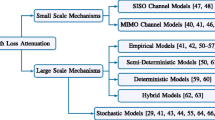Abstract
In this paper we study the so-called random waypoint (RWP) mobility model in the context of cellular networks. In the RWP model the nodes, i.e., mobile users, move along a zigzag path consisting of straight legs from one waypoint to the next. Each waypoint is assumed to be drawn from the uniform distribution over the given convex domain. In this paper we characterise the key performance measures, mean handover rate and mean sojourn time from the point of view of an arbitrary cell, as well as the mean handover rate in the network. To this end, we present an exact analytical formula for the mean arrival rate across an arbitrary curve. This result together with the pdf of the node location, allows us to compute all other interesting measures. The results are illustrated by several numerical examples. For instance, as a straightforward application of these results one can easily adjust the model parameters in a simulation so that the scenario matches well with, e.g., the measured sojourn times in a cell.
Similar content being viewed by others
References
C. Bettstetter, H. Hartenstein and X. Pérez-Costa, Stochastic properties of the random waypoint mobility model, ACM/Kluwer Wireless Networks: Special Issue on Modeling and Analysis of Mobile Networks, 10 (September 2004).
C. Bettstetter and C. Wagner. The spatial node distribution of the random waypoint mobility model, in: Proceedings of German Workshop on Mobile Ad Hoc networks (WMAN), Ulm, Germany (March 2002).
C. Bettstetter. On the connectivity of Ad Hoc networks, Computer Journal 47 (July 2004) 432–447.
C. Bettstetter, G. Resta and P. Santi, The node distribution of the random waypoint mobility model for wireless ad hoc networks, IEEE Transactions on Mobile Computing 2 (July–September 2003) 257–269.
D. Gross and C.M. Harris, Fundamentals of Queueing Theory (John Wiley & Sons, third edition, 1998).
E. Hyytiä, P. Lassila, L. Nieminen and J. Virtamo, Spatial node distribution in the random waypoint mobility model, Technical Report TD(04)029, COST279 (September 2004).
E. Hyytiä and J. Virtamo. Random waypoint model in $n$-dimensional space, Operations Research Letters 33 (2005) 561–571.
D.B. Johnson and D.A. Maltz. Dynamic source routing in ad hoc wireless networks, in: T. Imielinski and H. Korth, editors, Mobile Computing, volume 353 (1996) pp. 153–181. Kluwer Academic Publishers.
P. Lassila, E. Hyytiä and H. Koskinen, Connectivity properties of random waypoint mobility model for ad hoc networks, in: The Fourth annual Mediterranean workshop on Ad Hoc Networks (Med-Hoc-Net 2005) (Île de Porquerolles, France, June 2005).
W. Navidi and T. Camp. Stationary distributions for the random waypoint mobility model, IEEE Transactions on Mobile Computing 3 (January-March 2004) 99–108.
J.R. Norris, Markov Chains (Cambridge University Press, 1997).
G. Resta and P. Santi. An analysis of the node spatial distribution of the random waypoint model for Ad Hoc networks, in: Proc. ACM Workshop on Principles of Mobile Computing (POMC) (October 2002) pp. 44–50, Toulouse, France.
Sheldon M. Ross, Introduction to Probability Models (Academic Press, 7th edition, 2000).
J. Yoon, M. Liu and B. Noble, Random waypoint considered harmful, in: Proceedings of Infocom ’03 (San Fransisco, California, USA, April 2003) pp. 1312–1321.
Author information
Authors and Affiliations
Corresponding author
Additional information
This work has been supported by the Academy of Finland (grant n:o 74524) and the Finnish Defence Forces Technical Research Center.
Esa Hyytiä received the M.Sc. (Tech.) degree in engineering physics and Lic.Sc. (Tech.) and Dr.Sc. (Tech.) degrees in electrical engineering from the Helsinki University of Technology, in 1998, 2001 and 2004, respectively. He is currently working in the Centre for Quantifiable Quality of Service in Communication Systems at the Norwegian University of Science and Technology, Trondheim, Norway. His research interests include performance analysis, design and optimization of optical and wireless networks.
Jorma Virtamo received the M.Sc. (Tech.) degree in engineering physics and D.Sc. (Tech.) degree in theoretical physics from the Helsinki University of Technology, in 1970 and 1976, respectively. In 1986, he joined the Technical Research Centre of Finland, VTT Information Technology, where he led a teletraffic research group, and became a Research Professor in 1995. Since 1997 he has been a Professor in the Networking Laboratory of the Helsinki University of Technology. His current research interests include queueing theory and performance analysis and control of the Internet, wireless networks and ad hoc networks.
Rights and permissions
About this article
Cite this article
Hyytiä, E., Virtamo, J. Random waypoint mobility model in cellular networks. Wireless Netw 13, 177–188 (2007). https://doi.org/10.1007/s11276-006-4600-3
Published:
Issue Date:
DOI: https://doi.org/10.1007/s11276-006-4600-3




